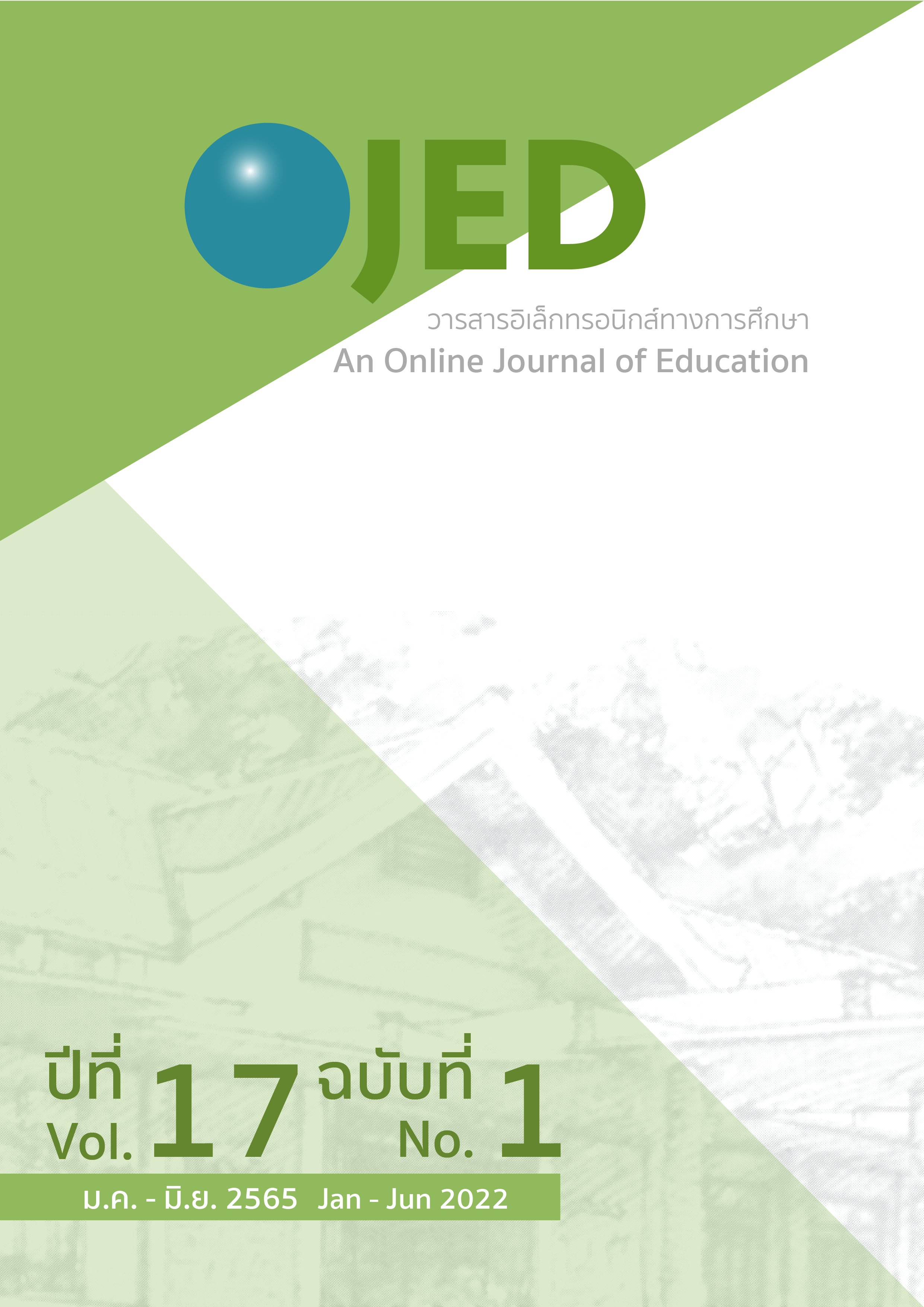The Effects of Dialogic Teaching in CLIL Science Subject on English Oral Communication Ability of Primary Students in English Program
DOI:
https://doi.org/10.14456/ojed.2022.19Keywords:
Content and language integrated learning (CLIL) Science, Dialogic teaching, English oral communication abilityAbstract
This present study aimed 1) to investigate the effects of dialogic teaching in CLIL Science subject in enhancing English oral communication ability of third grade students studying in an English program and 2) to explore the opinions of students towards dialogic teaching in CLIL Science. The study employed a one group pretest-posttest research design in which forty third grade students studying in an English program at a private school in Phra Nakhon Si Ayutthaya Province participated in the study for a total of 11 weeks. The research instruments employed were 1) an English oral communication ability pretest and posttest 2) an English oral communication ability analytic rubric and 3) students’ opinions interview questions. The results of this study indicated that 1) the students’ English oral communication ability significantly increased after the treatment and 2) most students have positive opinions towards dialogic teaching in CLIL Science subject.
References
Alexander, R. (2010). Dialogic teaching essentials. Cambridge.
Alexander, R. (2018). Developing dialogic teaching: Genesis, process, trial. Research Papers in Education, 33(5), 561-598.
Ang, M., Kian, K. W. C., & Yun, S. S. X. (2019). Use of dialogic teaching to enhance inferential skills in reading. ELIS Classroom inquiry.
Black, L. W. (2005). Dialogue in the lecture hall: Teacher–student communication and students’ perceptions of their learning. Qualitative Research Reports in Communication, 6(1), 31-40.
Brown, H. D. (2014). Principles of langauge learning and teaching: A course in second language acquisition (6th ed.). Pearson.
Chow, B. W.-Y., Hui, A. N.-N., Li, Z., & Dong, Y. (2021). Dialogic teaching in English-as-a-second-language classroom: Its effects on first graders with different levels of vocabulary knowledge. Language Teaching Research, 1-23. https://doi.org/https://doi.org/10.1177/1362168820981399
Coyle, D. (2007). Content and language integrated learning: Towards a connected research agenda for CLIL pedagogies. International journal of Bilingual Education Bilingualism, 10(5), 543-562.
Coyle, D., Hood, P., & Marsh, D. (2010). CLIL. Cambridge University Press.
Coyle, D., Hood, P., & Marsh, D. (2010). Content and language integrated learning. Ernst Klett Sprachen.
Evnitskaya, N. (2018). Classroom interaction and language learning in CLIL contexts. Journal of Innovation and Research in Plurilingual and Pluricultural Education, 1(1), 7-17.
Huang, Y. C. (2020). The effects of elementary students' science learning In CLIL. English Language Teaching, 13(2), 1-15.
Lee, R. J. R. J. (2016). Implementing dialogic teaching in a Singapore English language classroom. 47(3), 279-293.
Muhonen, H., Pakarinen, E., Lerkkanen, M.-K., Barza, L., & Von Suchodoletz, A. (2018). Patterns of dialogic teaching in kindergarten classrooms of Finland and the United Arab Emirates. Learning, Culture and Social Interaction, 25, 1-12. https://doi.org/https://doi.org/10.1016/j.lcsi.2018.11.011
Sedlacek, M., & Sedova, K. (2017). How many are talking? The role of collectivity in dialogic teaching. International Journal of Educational Research, 85, 99-108.
Shea, D. P. (2019). Trying to teach dialogically: The good, the bad, and the misguided. Language Teaching Research, 23(6), 787-804.
Sinclair, J. M., & Coulthard, M. (1975). Towards an analysis of discourse: The English used by teachers and pupils. Oxford University Press.
Teo, P. (2016). Exploring the dialogic space in teaching: A study of teacher talk in the pre-university classroom in Singapore. Teaching Teacher Education, 56, 47-60.
Van der Veen, C., De Mey, L., Van Kruistum, C., & Van Oers, B. (2017). The effect of productive classroom talk and metacommunication on young children’s oral communicative competence and subject matter knowledge: An intervention study in early childhood education. Learning Instruction, 48, 14-22.
Van der Veen, C., Michaels, S., Dobber, M., Van Kruistum, C., & Van Oers, B. (2021). Design, implementation, and evaluation of dialogic classroom talk in early childhood education. Learning, Culture and Social Interaction, 29, 100515.
Van der Wilt, F., Bouwer, R., & Van der Veen, C. (2021). Dialogic classroom talk in early childhood education: The effect on language skills and social competence. Learning and Instuction, 76, 1-10. https://doi.org/https://doi.org/10.1016/j.learninstruc.2021.101522
Vygotsky, L. S. (1978). The role of play in development. Mind in Society, 5, 92-104.
Vygotsky, L. S. (1980). Mind in society: The development of higher psychological processes. Harvard University Press.
Yin, Q., Yang, W., & Li, H. (2020). Blending constructivism and instructivism: A Study of classroom dialogue in Singapore kindergartens. Journal of Research in Childhood Education, 1-18.
Zuheer, K. M. M. (2008). The effect of using a program based on cooperative learning strategy on developing some oral communication skills of students at English department, faculty of education, Sana'a university [Master's Thesis, Assiut University].
Downloads
Published
How to Cite
Issue
Section
License
Copyright (c) 2022 An Online Journal of Education

This work is licensed under a Creative Commons Attribution-NonCommercial-NoDerivatives 4.0 International License.




